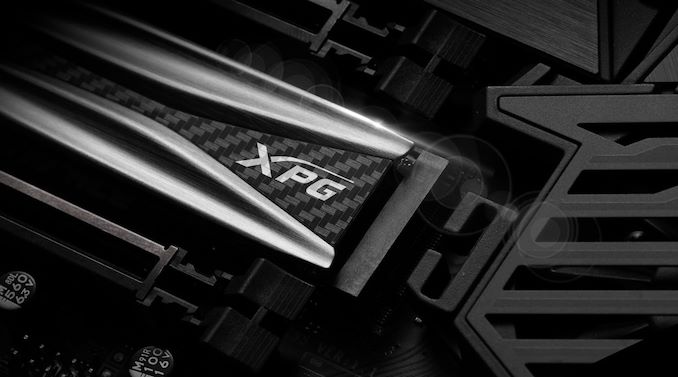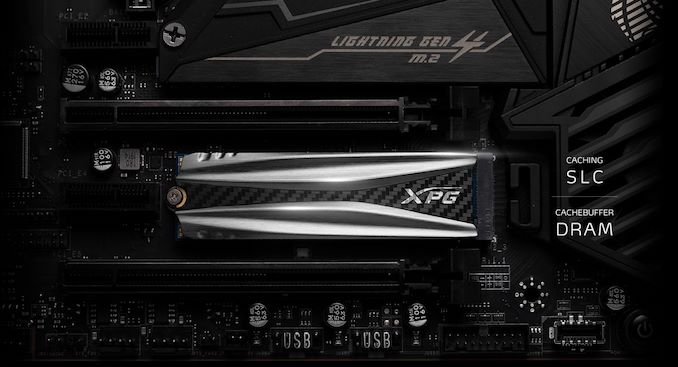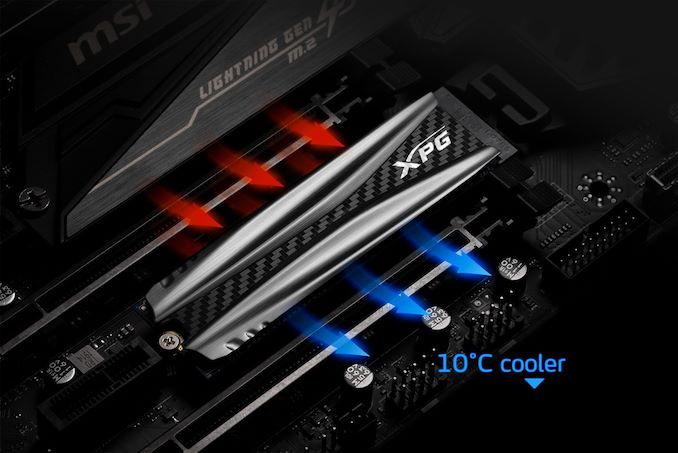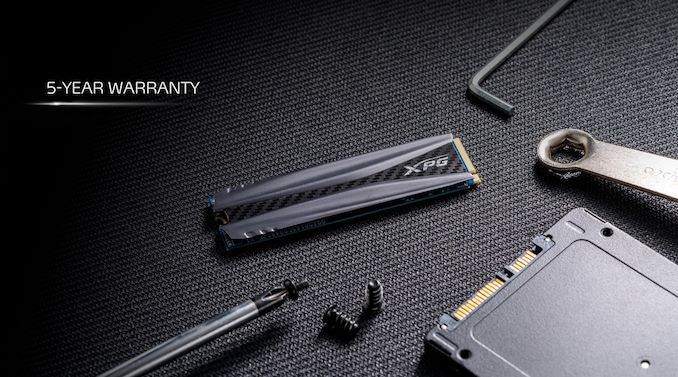ADATA Launches XPG Gammix S50: A PCIe 4.0 x4 SSD
by Anton Shilov on July 31, 2019 11:00 AM EST- Posted in
- SSDs
- Storage
- ADATA
- XPG
- Phison
- 3D TLC
- PCIe 4.0
- PS5016-E16
- XPG Gammix S50

ADATA has introduced its first PCIe 4.0 x4 NVMe SSD, which is aimed at the latest AMD Ryzen-based PCs using the AMD X570 platform. The ADATA XPG Gammix S50 will be the company’s new flagship drive for users looking for the maximum performance possible today.
Set to be available in 1 TB and 2 TB capacities, the XPG Gammix S50 drive is based on Phison’s PS5016-E16 controller (the only PCIe 4.0 SSD controller available today) paired with 3D TLC NAND memory. The drive comes in an M.2-2280 form-factor and features a PCIe 4.0 x4 interface (an, of course, the unit is backwards compatible with PCIe 3.0 systems). What is a bit surprising is that unlike other SSDs powered by the same controller, ADATA’s XPG Gammix S50 is not equipped with a large heat spreader, but comes with a relatively regular sized one.
As far as performance is concerned, ADATA says that the XPG Gammix S50 offers up to 5000 MB/s sequential read speeds and up to 4400 MB/s sequential write speeds when SLC caching is used (data based on CDM benchmark). Meanwhile, the SSD is rated for up to 750K random read/write IOPS.
When it comes to endurance and reliability levels, the XPG Spectrix S50 drives feature up to 1800 or 3600 TB written over a five-year warranty period, depending on the drive's capacity.
| ADATA XPG Gammix S50 Specifications | ||
| Capacity | 1 TB | 2TB |
| Model Number | AGAMMIXS50-1TT-C | AGAMMIXS50-2TT-C |
| Controller | Phison PS5016-E16 | |
| NAND Flash | 3D TLC NAND | |
| Form-Factor, Interface | M.2-2280, PCIe 4.0 x4, NVMe 1.3 | |
| Sequential Read | 5000 MB/s | |
| Sequential Write | 4400 MB/s | |
| Random Read IOPS | 750K IOPS | |
| Random Write IOPS | 750K IOPS | |
| Pseudo-SLC Caching | Supported | |
| DRAM Buffer | Yes, capacity unknown | |
| TCG Opal Encryption | No | |
| Power Management | 0.8W Active (Typical) 0.05W Slumber (Typical) DevSleep |
|
| Warranty | 5 years | |
| MTBF | 1,700,000 hours | |
| TBW | 1800 TB | 3600 TB |
| Additional Information | Link | |
| MSRP | $258 | $484 |
ADATA’s XPG Gammix S50 will be available in the near future. Prices will vary by region.
Related Reading:
- Phison’s PS5016-E16 & PS5019-E19: The First PCIe 4.0 Client SSD Controllers
- Phison PS5016-E16 PCIe 4.0 SSDs: Random Read/Write Performance Disclosed
- TeamGroup Cardea Zero PCIe 4.0 x4 SSD: Up to 1 TB
- More 2TB PCIe 4.0 SSD Options: Patriot with Custom Firmware coming Q4
- Galax Goes White: A PCIe 4.0 2TB SSD with a White PCB
Source: ADATA













11 Comments
View All Comments
Manabu - Wednesday, July 31, 2019 - link
I expected the new PCIe 4.0 drives to immediately saturate the extra bandwidth, at least when working from cache. On the other hand, I expect it to be more affordable if that is not the case.LtGoonRush - Wednesday, July 31, 2019 - link
The controllers are basically pegged right now. I'm thinking we will see improvements with firmware optimized for higher speeds, but they have a hard enough time saturating PCIe 3.0 so expect much from PCIe 4.0 before the second generation of controllers may be a bit unrealistic.deil - Thursday, August 1, 2019 - link
5/4.4 is quite close to the top 6.something that will be physically possible with ECC re transmission.I still call it damn impressive bump as it was like 3/3.1/3.2 5... a lot of things could have failed in between.
jabber - Wednesday, July 31, 2019 - link
Just as disappointing as PCIe 3.0 x4 was. Never has so much extra bandwidth ended with "Oh...not much different to my old SATA!"DigitalFreak - Thursday, August 1, 2019 - link
Don't listen to the marketing hype of NVMe. Normal desktop users aren't going to see much of, if any, real world difference between a good SATA SSD and an NVMe one.Ashinjuka - Wednesday, July 31, 2019 - link
Pondering how we're supposed to interpret that image depicting hot air flowing in and cool air flowing out. Maybe this thing runs on some new informational entropy physics theory.Santoval - Wednesday, July 31, 2019 - link
This SSD is so advanced it reverses the second law of thermodynamics while decreasing the entropy of the system! It also breaks the first law of thermodynamics and probably also the third one. Carnot and Clausius would have killed to play with this SSD. Carnot would have ditched or revised his Carnot's theorem as well, and so the industrial revolution would have taken a very different form :)oRAirwolf - Wednesday, July 31, 2019 - link
New technology is awesome and I am excited for it. That being said, as far as I am aware, SSD's like this one provide no improvement over a good SATA III SSD when doing things like loading games, launching web browsers, booting, etc. It frustrates me how most reviews don't look at this information. Synthetic benchmarks are cool and necessary to objectively test SSD's, but the addition of some basic scenarios like those listed above would help a lot of people make an informed decision about where they want to put their money. Unless you are something like a content creator working with massive sequential datasets, I just don't see the appeal of one of these PCIe 4.0 SSD's right now. I'd rather put that extra money into the next performance tier of graphics card or extra capacity in a slower SSD.Death666Angel - Wednesday, July 31, 2019 - link
Since your comment is about M.2 PCIe in general, I'll answer it from the perspective of someone who has 2 PCIe M.2 drives (= 3 TB of storage). If you want the M.2 form factor, some motherboards only offer one SATA M.2 and the other one is always connected by PCIe. So if you want more than one M.2 or make use of all the slots, PCIe M.2 is the only way.For me, being a SFF fan and having a small micro ATX case with little space, I didn't want even 2.5" SSDs/HDDs, mostly for the cabling. I already had a 1TB 960 Evo and wanted another 1 or 2 TB drives for my general data, like picutres, music, videos, documents, that I want access to without spinning up my NAS. The cheapest 1TB SSD with 3D TLC is about 95€ (Patriot Burst, the BX500 is 98€). The cheapest SATA M.2 is the MX500 at 105€ and that is 1€ cheaper than the SATA version. That is only 10€ difference for a form factor that is much more versatile and convenient in my opinion, since I can convert it to 2.5" and I even have a USB enclosure for M.2 (one SATA and one PCIe). But then you keep looking and you notice that PCIe M.2 1TB start around 120€ and one of the better ones was 135€ at the time (MP510). That is a 40€ difference. There isn't a lot of upgrades you can get fo 40€. And if you look at 1.92TB or more, the cheapest 3D TLC 2.5" drive is an MX500 for 230€. The cheapest M.2 SATA is the SanDisk X600 for 280€ and the cheapest PCIe M.2 is the MP510 for 270€ (Muskin Pilot-E is listed for 254€ pre-order). I paid 251€ via Amazon when there was a 10€ coupon around Prime Day. There sometimes are Micron 1100 SSDs or so on ebay for 200€ 2TB. But still, I only paid 21/51€ more than the cheapest 2.5" SSD and even less than the cheapest M.2 SATA SSD. I could not have gotten an upgrade to my 32GB or the 2070 or the 3700x I bought. And the kicker is, the B450M Mortar I use has two M.2 slots, one is connected via PCIe 3.0 x4 and SATA to the CPU, the other is just 2.0 x4 to the chipset. So, according to everything I can find, I couldn't use my 960 Evo 3.0 drive in the 3.0 slot if I also had a SATA M.2 drive. Not 100% sure about this, since the manual doesn't mention the SATA connectivity on the M.2 slots at all (so it might even be worse), but a few websites list it as such.
So of course, I'm a niche. And while it was fun to watch my steam folder be copied at 1.3 GB/s, I doubt I actually notice the difference compared to normal SATA SSDs. However, the price delta on some of these drives, especially at higher capacities (where NAND is still the majority BOM compared to everything else) is not that large. And the flexibility (buy a 10€ PCIe adapter for one PCIe M.2 slot and one SATA M.2 slot, bam, you can use those in any system, but a 10 to 30€ M.2 SATA/PCIe to USB 3.0 adapter, bam, huge, fast, long lasting USB storage). Most of the time I'd pay the M.2 premium (be it SATA or PCIe) and even then, if the system is PCIe capable, I guess I'd pay the PCIe premium as well. Of course this only applies to my mid range to high end system. If those 50€ are the difference between a RX570 and RX580, sure. Or a 4 core and a 6 core (6 / 8 etc.). But I was just pointing out that there are considerations beyond "does it improve my felt performance". And that the price delta isn't as large when taking into account other premium components. :) Now for these 4.0 drives: they are just priced too damn high. :D Especially since it's not even a new controller in any of these. But that's just the early adopter tax with not competition.
tygrus - Thursday, August 1, 2019 - link
Yes, we ask too much and we are seeing diminishing returns for the extra performance in real world usage. A few edge cases remain for some to make use of the high performance. Others just need to optimise their software better.The first few non-SATA drives took a while before they got over R/W 1500/1000 MB/s. Current limitations: thermal limit of controller; limited number of chips & channels per 2280/22110 stick; storage chip internal and external data rates/speeds; PCIe to CPU to RAM and back again limitations. Everything needs another few generations and they will be closer and closer to the practical limit of 7200MB/s. VM host servers will love it, most IT users will be non-the-wiser.